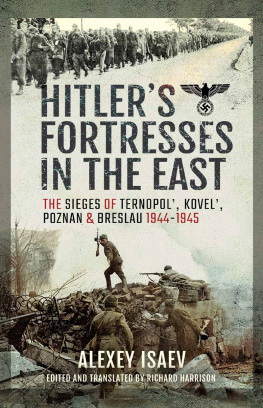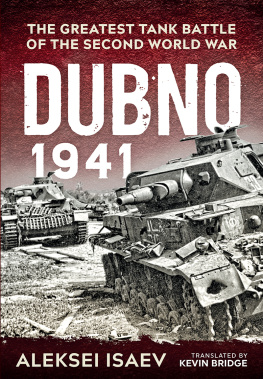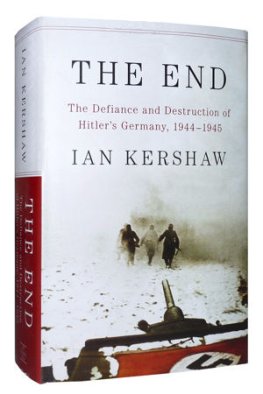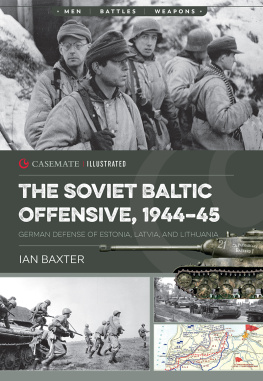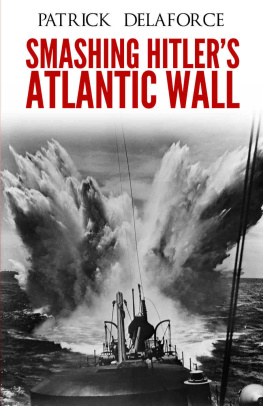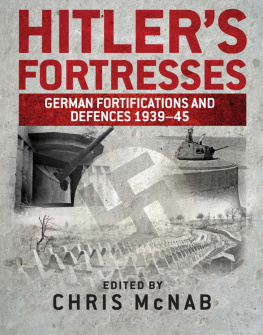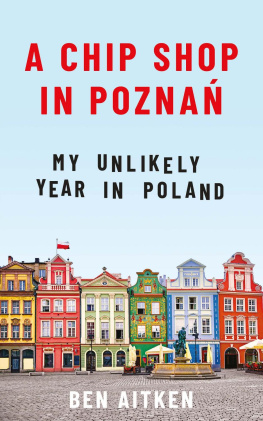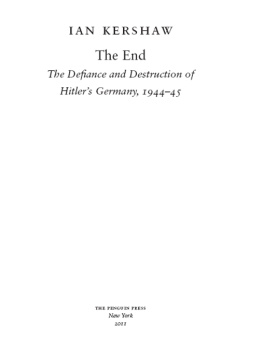Pagebreaks of the print version

Hitlers Fortresses in the East
Hitlers Fortresses in the East
The Sieges of Ternopol, Kovel, Poznan and Breslau, 19441945
Alexey V. Isaev
Edited and Translated by Richard W. Harrison
First published in Great Britain in 2021 by
Pen & Sword Military
An imprint of
Pen & Sword Books Ltd
Yorkshire Philadelphia
Copyright Alexey V. Isaev 2021
Copyright English Translation Pen & Sword Books 2021
ISBN 978 1 52678 395 0
eISBN 978 1 52678 396 7
Mobi ISBN 978 1 52678 397 4
The right of Alexey V. Isaev to be identified as Author of this work has been asserted by him in accordance with the Copyright, Designs and Patents Act 1988.
A CIP catalogue record for this book is available from the British Library.
All rights reserved. No part of this book may be reproduced or transmitted in any form or by any means, electronic or mechanical including photocopying, recording or by any information storage and retrieval system, without permission from the Publisher in writing.
Pen & Sword Books Limited incorporates the imprints of Atlas, Archaeology, Aviation, Discovery, Family History, Fiction, History, Maritime, Military, Military Classics, Politics, Select, Transport, True Crime, Air World, Frontline Publishing, Leo Cooper, Remember When, Seaforth Publishing, The Praetorian Press, Wharncliffe Local History, Wharncliffe Transport, Wharncliffe True Crime and White Owl.
For a complete list of Pen & Sword titles please contact
PEN & SWORD BOOKS LIMITED
47 Church Street, Barnsley, South Yorkshire, S70 2AS, England
E-mail:
Website: www.pen-and-sword.co.uk
Or
PEN AND SWORD BOOKS
1950 Lawrence Rd, Havertown, PA 19083, USA
E-mail:
Website: www.penandswordbooks.com
List of Illustrations
The commander of a motorized battalion of automatic riflemen, Captain G.T. Dobrunov (in the centre) with comrades next to a BA-64 armoured car. 4th Guards Tank Corps, 60th Army.
I.D. Chernyakhovskii, commander of the 60th Army, photographed in the summer of 1944. In his command post as commander of the Third Belorussian Front, after being promoted to general and receiving his second star (Hero of the Soviet Union) (29 July 1944).
I.I. Lyudnikov, commander of the 15th Rifle Corps. The successful storming of Ternopol would facilitate his appointment as an army commander in Belorussia.
An abandoned Panther from the 7th Panzer Division on the street in Ternopol. (TsAMO)
A knocked-out Sturmgeschutz assault gun on the street in Ternopol. (TsAMO)
A knocked-out SU-152 self-propelled gun in Ternopol. (TsAMO)
A parachute-dropped supply container on the roof of one of the buildings in Ternopol (from a newsreel clip).
A burnt-out transport glider on the street in Ternopol. (TsAMO)
Soviet infantry in the street fighting for Ternopol.
The railway station in Ternopol. (TsAMO)
A Maxim machine gun team putting its weapon in order.
A panoramic view of the approaches to Kovel from the roof of the railway station.
The Catholic church in Kovel. An enormous structure built in the 1930s.
An He-111 bomber abandoned on the airfield at Poznan. In all, according to Soviet data, about 150 aircraft of various types were captured in the Poznan area.
A sketch of one of the typical Poznan forts.
General V.I. Chuikov, commander of the 8th Guards Army.
A ditch around one of Poznans forts. Gun limbers have been positioned in the ditch, which was probably used as a storehouse for artillery equipment.
Fort Rauch in Poznan. A photograph from the beginning of the twentieth century.
Embrasures in one of the casemates of the fortresss citadel.
Soviet officers by a redoubt in the fortresss citadel.
A building destroyed by heavy artillery on the approaches to the central part of the old city. It had been turned into a centre of resistance by the Germans and suffered heavily during the assault.
The ditch of the citadel. The wall running along the centre of the ditch was not an organic structure and most likely speaks to an attempt to employ the ditch as a storehouse or even a factory.
The remains of a structure, which was probably a factory shop, of unknown purpose, in the citadel ditch. Such structures reduced the value of a ditch as an engineer obstacle, because they cut off a sector of fire of the machine guns firing on the ditch.
A photograph that clearly demonstrates the solidity of the brickwork of the nineteenth-century fortress. A hit by a heavy shell has only made a shallow dent in the wall. Several hits were required to pierce it.
The citadels redoubt No. 1 following an artillery preparation. Despite the fact that the artillery preparation destroyed all of the vegetation that had grown up over the years in the earth around the fortress structures, the redoubts themselves and parts of the forts remained intact.
They managed to make a break in the citadel wall by several successful hits in the same place with 203mm shells. Such a breach would them enable the attackers to break into the interior of the fortress.
A passageway into the fortress for tanks, self-propelled guns and heavy artillery, formed by the explosion of two tons of explosives.
A bridge built by engineers over the citadels ditch. The men standing at the base look like dwarves.
A Soviet 37mm anti-aircraft gun on the approaches to Breslau. Anti-aircraft weapons became the main enemy of the air bridge.
A Ju-52 transport aircraft, which was shot down over Breslau and fell on the city.
General V.A. Gluzdovskii, the commander of the 6th Army (in the centre), with a group of headquarters officers.
An armoured shelter for a sentry at one of Breslaus factories. This was for taking cover during air attacks.
An 88mm gun buried by the ruins of a building on a street in Breslau.
The results of work by a heavy demolition group: a multi-storey building has been completely reduced to rubble.
A 122mm M-30 howitzer crew, commanded by Sergeant Golubok of the 218th Rifle Division.
A gun crew, commanded by Senior Sergeant Plotnikov, from the 218th Rifle Divisions anti-tank battalion.
Aside from anti-aircraft guns, an obstacle on the path of Ju-52s flying to Breslau were DshK anti-aircraft machine guns.
The PTRS-41 anti-tank rifle as an anti-material rifle in street fighting. Firing points in the buildings became their main target.
An assault group overcomes a barricade.
Artillery observers at work. It was significantly more difficult for them to work in a city than in the open.
A 122mm M-30 howitzer in position for firing over open sights. Despite the weapons significant weight, the effectiveness of its fire made up for the difficulty of moving it into position.
A building with holes made by 122mm shells. The machine gun, which was silenced, was in the area of the door.
A building badly damaged by hits from 122mm shells. A Lend-Lease Studebaker stands by the building.
A barricade in Block 608.
A 88mm gun abandoned on Hindenburg Square.
A building after a direct hit by a 152mm shell.
A building badly damaged by hits from 152mm shells.
A block bombarded by 152mm guns. Despite the slight outward damage, the interiors of the buildings were heavily damaged.
A building hit by a 203mm shell. The interior of the building was heavily damaged.

